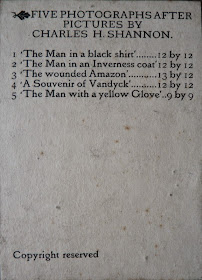This week's contribution is written by Vincent G. Barlow, whose website on '19th and 20th Century Books and Prints' is worth checking out.
A Portfolio of Five Photographs after Pictures by Charles H. Shannon
In my recent article on a rare Ricketts and Shannon portfolio publication (see A Portfolio of Woodcuts by T. Sturge Moore, blog No. 58) I described a copy of the portfolio 'Metamorphoses of Pan and other Woodcuts by T. Sturge Moore' published in 1895. This was one of a series of portfolios showing works by members and associates of the Dial circle of artists of the 1890s including as well as the Sturge Moore, two of wood-engravings by Lucien Pissarro, three of lithographs by Charles Shannon, and one of lithographs by William Rothenstein.
There is, however, one more portfolio in this series about which even less is known than those mentioned above. I refer to that entitled Five Photographs after Pictures by Charles H. Shannon published around August 1899. I shall give a description of a copy of this portfolio which I have in my collection later in this article.
I would first like to offer a little information and background leading up to its publication.
Although Ricketts and Shannon did, on occasion, exhibit works in the mid 1880s it was decided not to exhibit again for some time as stated in a letter sent from the Vale c.1889 to J.W. Gleeson White in which Shannon writes 'There is no great hurry with regard to the picture gallery prices etc. as we do not contemplate exhibiting ourselves for at least two or three years' (from a letter in my collection).
It was in fact not until the Summer of 1897 that Shannon began to exhibit his oil paintings in earnest when he was awarded a gold medal at the Annual Exhibition of the Fine Arts at the Royal Crystal Palace in Munich. The two paintings which won him the first class prize were 'A Wounded Amazon' and 'The Man with a Yellow Glove' both of which are included in the portfolio of five photographs.
 |
Charles Shannon, 'The Man with a Yellow Glove'
(photograph from A Portfolio of Five Photographs) |
In the meantime Ricketts and Shannon continued doing hack work, mainly illustrations and advertisements for magazines such as the Universal Review, Black & White, Atalanta, and others.
Shannon's last illustrative works were done for the books Daphnis and Chloe (published 1893), a joint effort in roughly equal proportions with Ricketts, and for Hero and Leander (published 1894) to which he contributed one of the seven illustrations namely 'Hermes disdains the amorous Destinies' (page 13). The illustration is very much influenced by Ricketts other drawings for the book and is almost indistinguishable from them. It remains, however, a very beautiful drawing in pen and grey ink on prepared paper. This drawing, a first state signed proof of the wood-engraving in black and a finished state signed proof in green are now in my collection.
 |
| Charles Shannon, original drawing for 'Hermes disdains the amorous Destinies' (collection of Vincent Barlow) |
On the completion of Hero and Leander it was decided that Shannon would cease doing illustrations and concentrate on his painting becoming 'the complete and undeniable master', while Ricketts would continue to work at the decorative arts and drawing illustrations and anything else to bring in 'a little money' (C.J. Holmes, Self & Partners (Mostly Self). London, 1936, p.164).
 |
| A List of Books Issued by Messrs. Hacon & Ricketts (1899) |
In 1899 the Portfolio of Five Photographs was probably published to show the artists' mastery of his art at this time. The only reference I have to it is in a Vale Press list of August/September 1899 which states "PHOTOGRAPHS. A Portfolio of five Photographs after Paintings by C.H. Shannon. Price three guineas net'.
The list is printed in Vale type. There is no mention of how many copies were published but due to its rarity, and taking into account the limited number of copies of the other published portfolios, one could guess at a figure of no more than twenty five copies or less.
 |
| A Portfolio of Five Photographs |
The portfolio itself consists of a wooden-hinged lidded box (630 x 485 x 25 mm), deep covered in dark green cloth. We know the maker of the box because of a printed label attached to the lower right hand inside corner which states: 'W.A. Fincham & Co., Box Manufacturers, 172, St. John Street E.C.'
 |
| Box maker's label in A Portfolio of Five Photographs |
On the inside of the lid is attached a piece of paper (c. 135 x 98 mm) with the title and list of contents and copyright statement ('Copyright reserved'), printed in Vale type.
 |
| List of contents in A Portfolio of Five Photographs |
The five photographs are laid down in closed grey paper fronted mounts measuring 605 x 455 mm each bearing the rubber stamp of the photographer on the back which reads 'Henry Dixon & Son, Photographers, 112, Albany Street, London. N.W.'
 |
| Photographer's stamp used in A Portfolio of Five Photographs |
The five photographs are listed 1-5 in this order:
1. The Man in a Black Shirt. (A self-portrait, 1897).
2. The Man in an Inverness Coat. (A portrait of Charles Ricketts, 1898).
3. The Wounded Amazon (1896) [There is an earlier lithographic version of this painting entitled 'Atalanta', 1893, as published in The Dial, number 4, 1896).
4. A Souvenir of Vandyck (1897).
5. The Man with a Yellow Glove. (A portrait of Thomas Sturge Moore, 1898).
The paintings represented at 3 and 5, were awarded a first place gold medal at the exhibition in Munich in 1897.
I would be pleased and grateful if any reader can supply more information regarding this elusive publication.
Vincent G. Barlow
 |
Charles Shannon, 'The Man in an Inverness Coat'
(photograph from A Portfolio of Five Photographs) |













